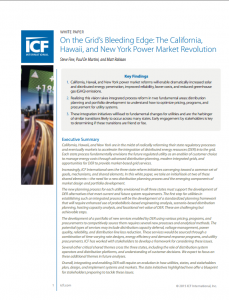Full Title: On the Grid’s Bleeding Edge: The California, Hawaii, and New York Power Market Revolution
Author(s): Steve Fine, Paul De Martini, and Matt Robison
Publisher(s): ICF International
Publication Date: July 1, 2015
Full Text: Download Resource
Description (excerpt):
California, Hawaii, and New York are in the midst of radically reforming their state regulatory processes and eventually markets to accelerate the integration of distributed energy resources (DER) into the grid. Each state process fundamentally envisions the future regulated utility as an enabler of customer choice to manage energy costs through advanced distribution planning, modern integrated grids, and opportunities for DER to provide market-based grid services. Increasingly, ICF International sees the three state reform initiatives converging toward a common set of
goals, mechanisms, and shared elements. In this white paper, we take an initial look at two of these shared elements—the need for a new distribution planning process and the emerging components of market design and portfolio development.
The new planning process for each utility envisioned in all three states must support the development of DER alternatives that meet current and future system requirements. The rst step for utilities in establishing such an integrated process will be the development of a standardized planning framework that will require enhanced use of probabilistic-based engineering analysis, scenario-based distribution planning, hosting capacity analysis, and locational net value of DER. These are challenging but achievable steps.
The development of a portfolio of new services enabled by DER using various pricing, programs, and procurements to competitively source them requires several new processes and analytical methods. The potential types of services may include distribution capacity deferral, voltage management, powerquality, reliability, and distribution line loss reduction. These services would be sourced through a combination of time-varying rate designs, energy e ciency and demand response programs, and utility procurements. ICF has worked with stakeholders to develop a framework for considering these issues. Several other critical shared themes cross the three states, including the role of distribution system operators and distribution platforms, and understanding of customer decisions. We expect to focus on these additional themes in future analyses.
Overall, integrating and enabling DER will require an evolution in how utilities, states, and stakeholders plan, design, and implement systems and markets. The state initiatives highlighted here o er a blueprint for stakeholders preparing to tackle these issues
